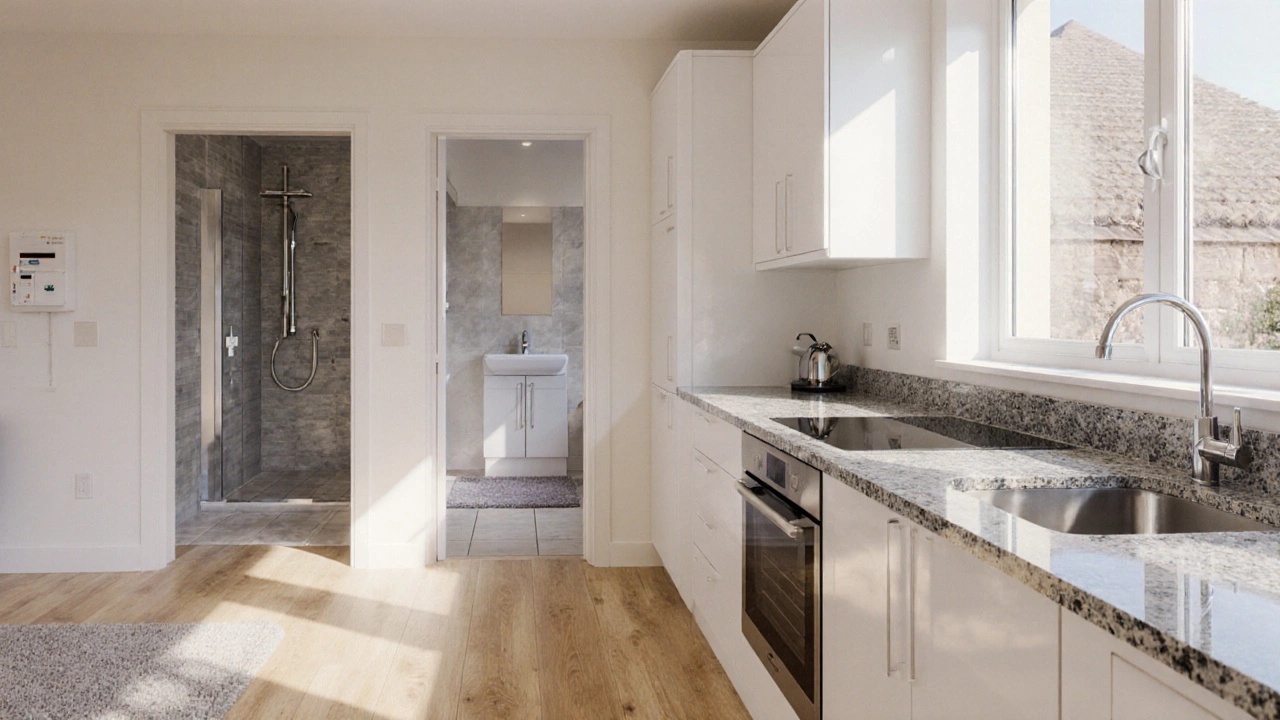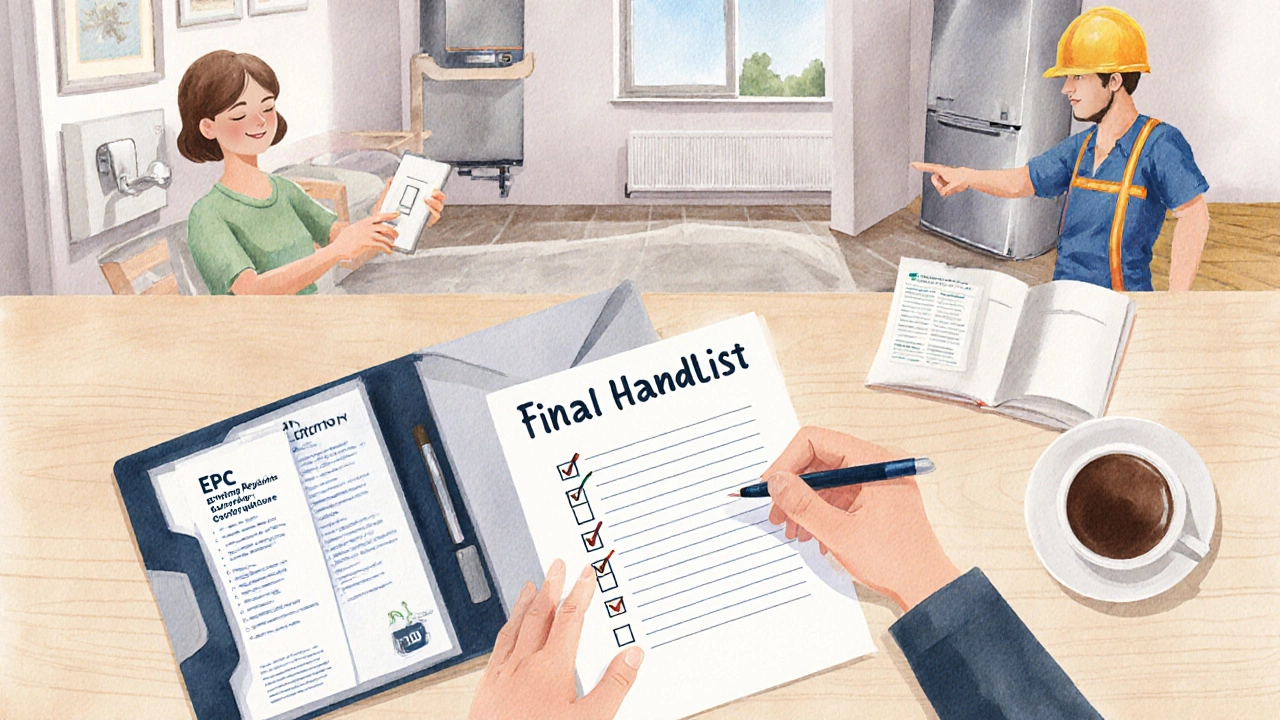New Build Home Checklist
Your New Build Handover Checklist
Complete each task as you go through your new home. Click on items to mark them as done.
Checklist Progress Summary
Standard Inclusions Overview
Here are the standard features typically included in a new build:
- Fixed kitchen cabinets, countertop, and built-in appliances
- Integrated bathroom suite with toilet, basin, and shower/tray
- Laminated flooring on upper levels, tiled flooring in wet areas
- Electrical wiring, sockets, and light switches
- Plumbing and heating system with gas boiler
- Insulation, double-glazed PVCu windows, and external cladding
- Driveway, boundary walls, and basic landscaping
When you buy a New Build a brand‑new house directly from a developer, the excitement is often matched by a flood of questions: What actually comes with it? Which items are guaranteed? How do I make sure nothing’s missing at handover?
Standard Inclusions You Can Expect
Most reputable Developer the company that plans, designs and constructs the house include a core set of fixtures and services to get you living right away. Below is a quick rundown of what you’ll typically find:
- Fixed kitchen cabinets, countertop, and built‑in appliances such as an oven and hob.
- Integrated bathroom suite - toilet, basin, shower tray or bathtub, and basic tiling.
- Floor finishes: laminated flooring on upper levels, tiled flooring in wet areas, and carpet in primary bedrooms.
- Electrical wiring, sockets, light switches, and a main consumer unit with circuit breakers.
- Plumbing and heating system, usually a gas‑powered boiler with radiators.
- Insulation meeting the latest energy standards, double‑glazed PVCu windows, and external cladding.
- External works such as driveway, boundary walls, and landscaping to a basic level.
Anything outside this list is generally considered an upgrade, and you’ll be asked to pay extra for it.
Warranty and Post‑Handover Support
One of the biggest advantages of a New Build a newly constructed property is the built‑in protection that comes with it. The most common schemes are:
- NHBC Warranty a ten‑year structural guarantee offered by the National House Building Council. It covers major defects like roof collapse, wall failures, and foundation movement.
- Structural Warranty often provided by the builder’s own insurance scheme, usually mirroring the NHBC coverage but at a slightly different cost.
- One‑year workmanship guarantee that deals with minor issues such as faulty fittings or unfinished paintwork.
All warranties require you to register the property within a set period - typically 28 days after completion - and to keep a detailed snagging list (see the next section) as evidence of any defects you discover.

Legal and Compliance Documents
Before you get the keys, the Contractor the builder responsible for the physical construction must hand over a bundle of paperwork that proves the build meets all regulations:
- Energy Performance Certificate (EPC) a rating that shows the home’s energy efficiency, required by law for every residential sale.
- Building Regulations Completion Certificate confirming the work complies with safety and construction standards.
- Completion Certificate issued by the local authority or private certifier confirming the house is ready for occupation.
- Guarantee of Title a legal statement that the developer owns the property and can transfer ownership.
These documents are crucial for future resale and for any insurance claims you might need to file.
Optional Upgrades - What You Can Add (and Pay For)
Most developers offer a menu of upgrades that can lift the finish level or improve energy efficiency. The table below compares the typical standard provision against popular optional extras.
| Feature | Standard | Optional Upgrade | Typical Cost Increase |
|---|---|---|---|
| Flooring | Laminate on upper floors, tile in bathrooms | Engineered hardwood throughout | £5,000‑£8,000 |
| Kitchen | U‑shaped cabinets, basic worktop | Premium soft‑close cabinets + quartz worktop | £3,000‑£6,000 |
| Heating | Standard gas boiler | Air‑source heat pump | £8,000‑£12,000 |
| Windows | PVCu double‑glazed | Triple‑glazed aluminium frames | £2,000‑£4,000 |
| Landscape | Basic grassed area | Hard‑scaped patio + irrigation | £3,500‑£7,500 |
When you decide on upgrades, ask the developer for a written quote that clearly separates the upgrade cost from the base price. This prevents surprise charges later on.

Your new build checklist for a Smooth Handover
Walking through the property on the final day can feel overwhelming. Follow this step‑by‑step list to make sure everything is where it should be.
- Bring a copy of the Snagging List a record of any defects or unfinished work prepared ahead of time.
- Check each room against the standard inclusions list - cabinets, appliances, fixtures, and finishes.
- Test all electrical points, light switches, and the consumer unit for correct labeling.
- Run hot water from each tap, flush toilets, and verify that the heating system fires up without leaks.
- Inspect windows and doors for proper sealing and operation.
- Confirm that the EPC rating matches the one shown in the sales brochure.
- Ask to see the Building Regulations Completion Certificate and the Completion Certificate; note the reference numbers.
- Take photos of any issues you find - this evidence strengthens your snagging claim.
- Sign the handover form only after all items on the snagging list have been addressed or formally agreed to be fixed later.
- Register the NHBC (or other) warranty within the required window and keep the warranty documents in a safe place.
Completing this checklist gives you confidence that the house is truly ready for you to move in.
Common Pitfalls and Pro Tips
- Don’t assume upgrades are included. Even a “deluxe” finish may be a marketing term; request a detailed specification sheet.
- Watch out for “interim” finishes - sometimes a developer will install carpet that’s meant to be replaced later. Verify final material in the contract.
- Make sure the Guarantee of Title is free of any encumbrances before signing the transfer deed.
- If you spot a defect after moving in, report it within the warranty registration period; otherwise you may lose coverage.
- Consider a third‑party survey even on a new build. An independent inspector can catch issues that the developer’s snagging team missed.
Frequently Asked Questions
What is typically included in a new build home?
Standard inclusions cover kitchen cabinets and basic appliances, bathroom suite, flooring, electrical wiring, heating system, insulation, double‑glazed windows, and external works like driveways. Anything beyond this list is usually an optional upgrade.
How long does the NHBC warranty last?
The NHBC warranty provides ten years of structural cover, with the first year covering most workmanship issues and the remaining nine years focusing on major defects like structural movement.
When should I register my new build warranty?
Registration must be completed within the period specified by the developer - usually within 28 days of the completion date. Missing the window can void the warranty.
What documents do I receive at handover?
You’ll get the Energy Performance Certificate, Building Regulations Completion Certificate, Completion Certificate, Guarantee of Title, and warranty paperwork. Keep them safe - they’re needed for insurance and future resale.
Can I negotiate upgrades after I’ve signed the contract?
It’s possible but depends on the developer’s policy. Some allow post‑contract upgrades for an additional charge; others lock the specification at signing. Ask for a written amendment to avoid disputes.





